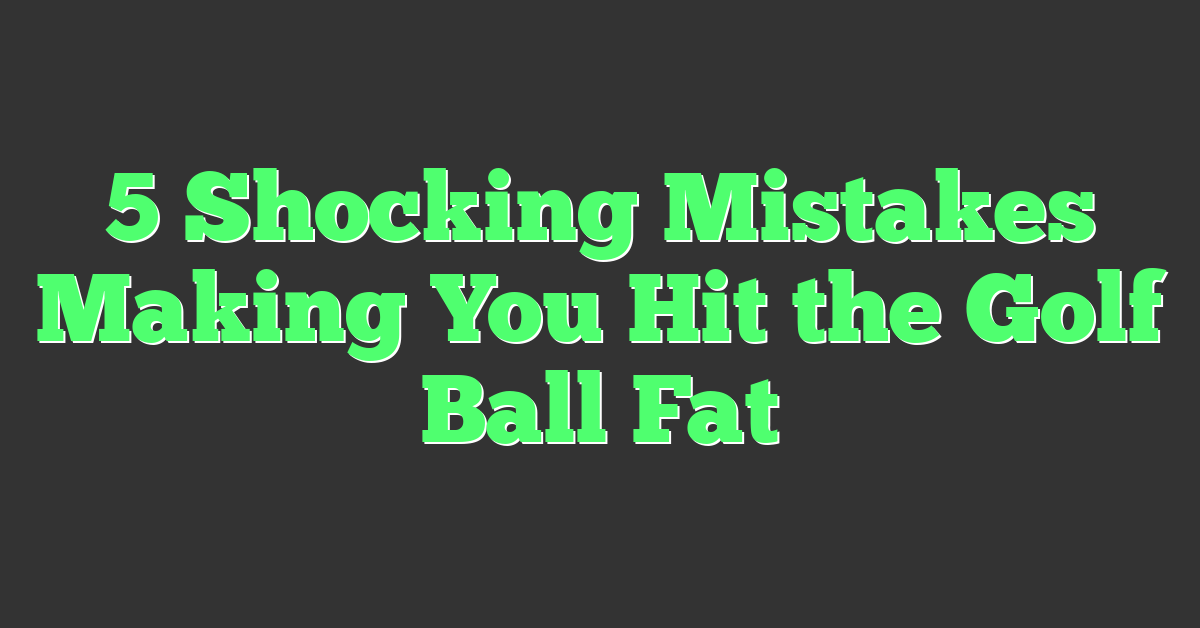Ever wondered why some golf balls seem to have a mind of their own once they hit the green? It’s all about the spin. The right golf ball can turn a good shot into a great one, hugging the turf or checking up just when you need it to.

Choosing a ball that offers the most spin can be a game-changer, especially around the greens where control is key. But with so many options on the market, finding the one that gives you that extra edge can feel like searching for a needle in a haystack.
Factors that affect golf ball spin
When you’re out there on the course, trying to shave points off your game, understanding the factors that influence golf ball spin is crucial. It’s not just about the ball itself; there’s a whole science behind it that can work to your advantage.
Firstly, ball construction plays a major role in spin. Multi-layered golf balls with a soft cover typically generate more spin compared to their two-piece, hard cover counterparts. The core, mantle, and cover all interact to affect the ball’s performance. A softer cover, like urethane, will grip the clubface longer and impart more spin, especially on short irons and wedges.
The type of club you’re using also has a significant impact. A driver will produce less spin due to its lower loft, whereas wedges with higher loft angles can dramatically increase spin rates. It’s essential to get a feel for how each club in your bag affects spin with each type of shot.
Swing speed and attack angle are personal factors that influence spin. Golfers with higher swing speeds can typically generate more spin, although that’s not always beneficial if it’s not controlled. The angle at which you strike the ball—hitting down on it or with a more level approach—can also change the spin dynamics.
Let’s not forget about course conditions:
- Wetness: A moist ball and clubface reduce friction and spin.
- Rough: Balls hit from taller grass tend to have less backspin.
- Fairways: Tight, well-groomed fairways allow for optimal spin on approach shots.
Mastering the science of golf ball spin begins with identifying how each of these factors plays into your game. Analyze your play across different conditions, with various clubs, and pay attention to the construction of the balls you use. This understanding will empower you to make the right choices on the course and ultimately lower your scores. Keep practicing – and remember, every detail counts in the pursuit of excellence in golf.
The importance of spin in golf
Ever wonder why spin is such a big deal in golf? Well, mastering spin can drastically change your approach to the game. Imagine having the ability to control your ball like it’s on a string – that’s what good spin allows you to do. Spin controls trajectory and affects how the ball behaves upon landing. Higher spin rates may cause the ball to soar through the air and stop dead on the greens, while lower spin can result in longer, penetrating shots with a roll.
Spin rates vary with different kinds of shots. Off the tee, you’re typically aiming for lower spin to maximize distance. This helps prevent ballooning, which can rob you of crucial yards. Conversely, on approach shots, you want that high spin to land softly, giving you the chance to set up an easy putt. With wedges, high spin rates are invaluable as you’re often trying to hit it close from short distances.
Consider these scenarios:
- On a wet day, high ball spin will help your ball stick on the green.
- With a back pin position, you’ll need enough spin to hold the green instead of rolling off the back.
- To navigate around obstacles, controlling the side-spin helps you hit a fade or draw.
Here’s where understanding and analyzing ball construction and how it aligns with club type and swing mechanics pays off. It’s not just about choosing a high-spin ball but also matching it with how you strike the ball. The differences between urethane and ionomer-covered balls, for instance, can significantly impact your game. Urethane typically provides a softer feel and higher spin, particularly useful around the greens.
Spin can’t be thought of in isolation, though. Remember, it’s one piece in the larger puzzle of your game. For instance, club selection and even Shaft Stiffness can influence spin. A stiffer shaft might reduce your spin rate, which could be beneficial or detrimental, depending on the shot at hand. Golf truly is a game of inches, and spin control is how you gain those inches – or lose them.
Getting this right takes time and practice. You’ll need to refine your technique, possibly tweak your equipment, and always, always think strategically.
Understanding the different types of golf ball spin
You’ve probably heard golfers talk about “putting some spin” on the ball. What they’re usually referring to are the two main types of spin: backspin and sidespin. Each type drastically impacts your game, so you’ll want to know how to harness and control them.
Backspin is what keeps your ball in the air longer, giving it lift. Think of it like the wings of an airplane. When you strike the ball with an iron, you’re actually compressing it against the face of the club. This compression, along with the grooves of the club, grabs the ball and imparts a backward rotation as it leaves the clubface. A higher backspin rate can help your ball stop quicker on the greens, which is especially useful with your approach shots. It’s the secret sauce to those jaw-dropping shots that land, dance, and then draw back toward the pin.
Sidespin occurs when your clubface isn’t square at impact, causing the ball to curve left or right. To curve the ball intentionally, like in a draw or fade, is a skill that’ll open up new pathways to the green and help you avoid obstacles. However, too much unintentional sidespin can lead to hooks or slices, so it’s critical to perfect your swing mechanics to control it.
Mastering these spins is all about the details in your shot:
- Ball Construction: Multi-piece balls are designed to react differently upon impact. A softer cover can enhance spin, while a harder cover might reduce it.
- Club Type: Wedges with fresher grooves can generate more spin, while drivers are optimized to lower spin to maximize distance.
- Swing Mechanics: The angle of attack, club speed, and path are some of the technicalities that define your ball’s spin characteristics.
Experiment with different club and ball combinations to see the varying spin rates. Use a launch monitor if possible; it can give you precise data to analyze, like the spin rate and the axis of spin, which directly correlate to how you’ve struck the ball. By tweaking these elements and practicing consistently, you’ll start to see your spin control—and your scores—improve.
How to measure golf ball spin
You’re on a mission to find the golf ball that spins the most, and precision is key. The first step is to measure the spin of each ball. This can seem daunting, but with the right tools, it’s a breeze. Essentially, you’ll need a launch monitor, which is an electronic device that measures various aspects of what happens to your golf ball at impact.

When you hit a golf shot, the launch monitor tracks the ball and provides a slew of data, including spin rate. Higher-end models like TrackMan or FlightScope give you a detailed analysis of each shot – they’re the go-to for many low handicap players who are serious about their game. But don’t sweat it if those are out of reach; more affordable alternatives may fit your needs without breaking the bank.
Make sure to use the same club when testing different balls to ensure consistency. Generally, a wedge or a short iron is ideal because these clubs are designed to maximize spin. Position the launch monitor so it can accurately track your ball’s flight. Once you’re set up, here’s what to do:
- Warm-up with a few shots to get into your rhythm.
- For each ball, take a series of shots, ensuring you’re hitting with a consistent stroke each time.
- Review the spin rates provided by the monitor after each shot, noting the averages.
Prepare a data sheet to record your findings. This is how you can keep track of spin rates easily:
| Golf Ball Model | Spin Rate 1 (rpm) | Spin Rate 2 (rpm) | Spin Rate 3 (rpm) | Average Spin Rate (rpm) |
|---|---|---|---|---|
| Example Ball A | 7,800 | 7,600 | 7,850 | 7,750 |
| Example Ball B |
Fill in the corresponding spin rates for each ball you test. Over time, you’ll see a clear picture of which balls spin the most under identical conditions.
Don’t forget that environmental factors like wind, temperature, and elevation can affect your results. It’s best to conduct your tests in similar weather conditions or indoors if possible. Remember, the more controlled the environment, the more reliable your data will be.

Popular golf balls known for their spin
When you’re on the quest to find a golf ball that complements your desire for maximum spin, knowing which balls have a reputation for their spin can be invaluable. Tour-level balls generally offer the most spin, as they’re designed to provide the control and feel that better players seek around the greens.
Let’s start with the Titleist Pro V1, a ball you’ve likely heard about even if you’re new to the game. It offers a significant amount of backspin without compromising distance. This is a ball that professionals and low-handicap golfers swear by because of its consistent performance.
Another powerhouse in the spin department is the Callaway Chrome Soft. What makes it stand out is its SoftFast Core, which is engineered to promote high-launch and low-spin on long shots and control and spin closer to the green.
For those who prioritize greenside control,** the TaylorMade TP5** is a solid choice — its five-layer construction provides a unique blend of distance, feel, and spin control. Each layer is specifically designed to perform a different function, ultimately leading to better performance on full shots and delicate pitches alike.
Here’s a quick rundown of some popular golf balls renowned for their spin characteristics:

- Titleist Pro V1
- Callaway Chrome Soft
- TaylorMade TP5
- Bridgestone Tour B XS
- Srixon Z-Star
But let’s not overlook the Bridgestone Tour B XS, used by none other than Tiger Woods. It’s especially known for its proprietary cover material that increases friction and thus, enhances spin.
Lastly, the Srixon Z-Star offers an energetic gradient growth core and a urethane cover that provides a balanced approach to distance and spin, making it a favorite among players who love shaping their shots.
Remember, while these balls are top-rated for their spin, your technique and the conditions you play in greatly influence their performance. You may find one of these balls to be the game-changer you’re looking for, but it’s critical to test them in various situations to truly gauge their impact on your game. Choosing the right ball is a personal journey, and with the right match, you’ll likely see a notable difference in your control and scoring.










